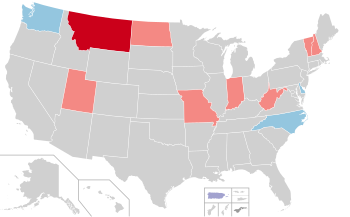| |||||||||||||||||||||||||||||||
13 governorships 11 states; 2 territories | |||||||||||||||||||||||||||||||
|---|---|---|---|---|---|---|---|---|---|---|---|---|---|---|---|---|---|---|---|---|---|---|---|---|---|---|---|---|---|---|---|
| |||||||||||||||||||||||||||||||
 Democratic hold Republican hold Republican gain New Progressive hold Nonpartisan politician | |||||||||||||||||||||||||||||||
United States gubernatorial elections were held on November 3, 2020, in 11 states and two territories. The previous gubernatorial elections for this group of states took place in 2016, except in New Hampshire and Vermont where governors only serve two-year terms. These two states elected their current governors in 2018. Nine state governors ran for reelection and all nine won,[a] while Democrat Steve Bullock of Montana could not run again due to term limits and Republican Gary Herbert of Utah decided to retire at the end of his term.[1]
In addition to state gubernatorial elections, the territories of American Samoa and Puerto Rico also held elections for their governors. Puerto Rican governor Wanda Vázquez Garced lost the New Progressive Party primary to Pedro Pierluisi,[2] while Lolo Matalasi Moliga of American Samoa could not run again due to term limits.[3]
The elections took place concurrently with the 2020 presidential election, elections to the House of Representatives and Senate, and numerous state and local elections. This round of gubernatorial elections marked the first time since West Virginia governor Jim Justice's party switch in mid-2017 that Republicans flipped any governorships held previously by Democrats, and the first round of gubernatorial elections since 2016 where Republicans made net gains, ending a streak of Democratic net gains that had occurred in prior elections during the presidency of Republican Donald Trump.
Cite error: There are <ref group=lower-alpha> tags or {{efn}} templates on this page, but the references will not show without a {{reflist|group=lower-alpha}} template or {{notelist}} template (see the help page).
- ^ Skelley, Geoffrey (April 7, 2020). "11 Governorships Are Up For Grabs In 2020. Here's What's Happening". FiveThirtyEight. Retrieved September 16, 2020.
- ^ "Puerto Rico's governor loses primary in chaotic election". POLITICO. Associated Press. Retrieved September 16, 2020.
- ^ "Four teams to vie for American Samoa's governorship". RNZ. September 3, 2020. Retrieved September 16, 2020.